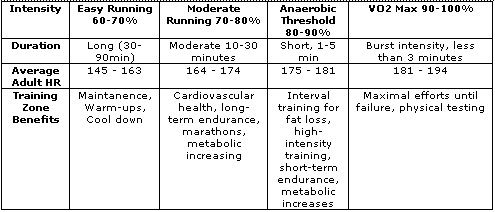
News
FitSmart: Heart rates and results
 WEB EXCLUSIVE
WEB EXCLUSIVE
FitSmart
Web columnist Brad Lawrence looks at myths about nutrition and sets us straight.
November 30, 1999
By Brad Lawrence
 |
FitSmart is a Fire Fighting in Canada online exclusive column by Brad Lawrence, a firefirefighter and personal trainer in Calgary, Alta. Brad can be reached at bradmlawrence@gmail.com |
|
FITNESS
During your time in and around the gym, you have probably noticed fitness-crazed individuals keeping track of their heart rates during their workouts. Have you ever stopped to wonder why this is worth writing down? Why are they wearing a heart-rate monitor or why do they bother to check their pulses? There is a method to the madness, and thanks to advances in technology, heart-rate training is easier than ever. Advertisement
Are you aware that a slight difference in your target heart rate can help you improve your cardiovascular conditioning or maximize fat loss? There is a difference but before we get into which heart rates trigger which results you need to determine your resting heart rate (RHR) and your maximum heart rate (MHR). First you have to determine your RHR. To calculate your resting heart rate simply take your pulse as soon as you wake up in the morning over a 30 second period. The average for an adult male is 72, 70 for females. Next, to determine your MHR, you must first ignore whats written on the treadmill in front of you. We’ve all been taught at some point in time that your MHR is 220 minus your age. While this may be accurate for an average individual, please keep in mind this method takes into account that everyone's resting heart rate is identical, which it isn’t. When I was in training to become a personal trainer this “220 minus age equals MHR” was taught to me as the “stupid method”. To properly calculate your MHR, it’s a good time-saving idea to use a heart rate calculator, www.bodyforlife2.com/max_heart_rate.htm . This calculator will give you several values you can use to better direct your training. It will use whats called the Karvonen method of HR calculation, which is far more personal and accurate. Now that you know your RHR and MHR apply them to your workouts. All modern cardio equipment has heart-rate monitoring capability, making it easy to keep track. Check the training benefits column below, and try to keep your heart rate within that specific zone. Remember the higher the percentage of MHR you achieve the longer your metabolism is increased. Normally after cardio training your metabolism stays elevated for two hours. If you are able to sustain your heart rate in the anaerobic zone, your metabolism will stay elevated for the 13 hours following your workout. Feeling like you’re out of gas in the gym is one thing but seeing your heart pushed near its limits is a whole new ball game. Knowing your average heart rates can provide knowledge about your body on everything from heart health to athletic performance. Keep a closer eye on the most important muscle in your body and reap the benefits.
|
NUTRITION
For those of you out of the loop, the fitness and nutrition industry has absolutely exploded. Along with this explosion of popularity comes an aftershock of information, and with an abundance of information comes conflict. For this we have to unfortunately blame the information (or sometimes mis-information) superhighway, the internet. With the installation of the internet, in what seems to be every location with a desk, people are overloaded with articles, seminars and studies from all over the globe. It’s a wonderful thing to have this amount of information at our fingertips, but unfortunately there seems to be a lot of conflicting information passed down the line. The key as a reader is being able to separate the good, the bad and the ugly. Lets take a look at some common nutrition myths that should have been dead a long time ago. Myth #1 – High protein diets can damage your kidneys Myth #2 – The ”golden hour” post-workout proteins Myth #3 – Skipping meals will help you lose weight In reality, if you’re eating properly you shouldn’t have intense food cravings much past 7 or 8 p.m. anyway. However, if you’re hungry it’s far better to eat regardless of the time of night than it is to go to bed on an empty stomach. If you’re hungry at night, a small portion will help to stabilize blood sugar and prevent musclular breakdown through the night. That being said, it’s important to distinguish hunger from thirst late at night. Most people who feel hungry late at night are actually being thirsty. Thirst is commonly mistaken for hunger, especially late at night if you’ve had high sodium meals the evening prior. Now, just because I’m saying it’s not a cardinal sin to eat in the evening doesn’t mean you can have a cheat meal. If you have a small meal before bed it needs to be clean. The only reason I would recommend limiting food intake late at night is that the growth hormone (GH) is released during sleep. GH is released when training and sleeping but is hindered if the body is digesting meals. Most professionals recommend striving for a 10- to 12-hour window between your last meal at night and your first meal in the morning If your breakfast will likely be at 8 a.m., make your last meal somewhere around 8 p.m. the night before. That will allow for the release of the growth hormone throughout the night. In an ideal world, I’d recommend a small meal in the evening consisting of protein without carbs or fats, and a 12-hour fast while sleeping to maximize GH production. Protein shakes or a small piece of chicken would be a good choice of food. Don’t overeat and don’t cheat. Those late-night calories can really add up. Remember, you’re trying to stabilize blood sugars, not shake them up. Conclusion |
Print this page
